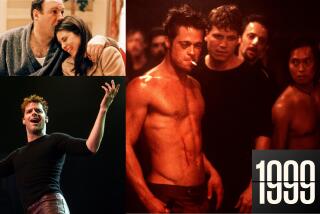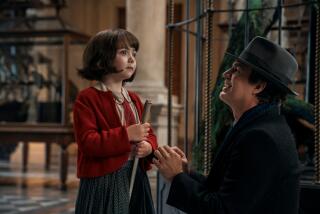A Year of Hope for Disabled on Film
As 1997 begins, we are confronted with many suggestions as to what were the significant themes and who were the significant people in 1996 (Calendar, “Crossroads” series).
But I think assessments of culture in 1996 are incomplete unless they take into account depictions of people with disabilities. I do not think that these depictions have always been commendable, nor have they always been reprehensible. But it is important to take note of these depictions because the degree to which disability is portrayed in movies is an important barometer of the time.
People don’t go to the movies to see unexceptional people do unexceptional things, so it’s not altogether surprising that, in a society fixated on issues of disability, this theme, especially when broadly construed, is often depicted.
“Shine” is justifiably at the top of many critics’ lists. David Helfgott is a brilliant pianist neither because of his disability nor in spite of his disability; he is successful with a disability.
Technically equally brilliant, although more likely to reinforce prejudices regarding people with disabilities, is the Danish movie “Breaking the Waves.” The movie depicts a love between two central characters--one disabled mentally, the other disabled physically--and, though it will leave most viewers incredulous at times, it helps us confront powerful social stigmas against those who are disabled.
Last year was also the year of the powerful drama, “Extreme Measures,” starring Hugh Grant. When Grant perceives (wrongly) that he has incurred a spinal injury, he begins to wonder if he wants to go on living, an inquiry that might be thought offensive by many people with disabilities who have not had occasion to wonder at all.
Of course, at that point Grant’s character is reasoning from the only perspective he has known, that of a non-disabled individual. The movie does, however, depict the importance of values other than “the cure,” as defined by medical experts, and focuses on the presence of people with disabilities in our society.
*
Lest we congratulate ourselves too much on our social consciousness, we should also remember that 1996 was the year of “The Hunchback of Notre Dame.” We learned that it was still highly profitable to market caricatures of people who are different.
The popular movie was accompanied by toys, key chains and a “Festival of Fools” at Disneyland. Not even donations to the National Scoliosis Foundation could deter a chorus of criticism of Disney from the disability press and disability community.
The end of the year witnessed a flurry of critically approved films, including “The People vs. Larry Flynt.” Part of the reason I look forward to seeing it is that, despite many people’s conviction that it is not a “disability movie,” I am convinced that it is.
People with disabilities are usually no different in almost every meaningful respect than people without disabilities. On the occasions in which movies tried to demonstrate this in 1996, they were at their best. They give us something to shoot for in 1997.
More to Read
Only good movies
Get the Indie Focus newsletter, Mark Olsen's weekly guide to the world of cinema.
You may occasionally receive promotional content from the Los Angeles Times.










